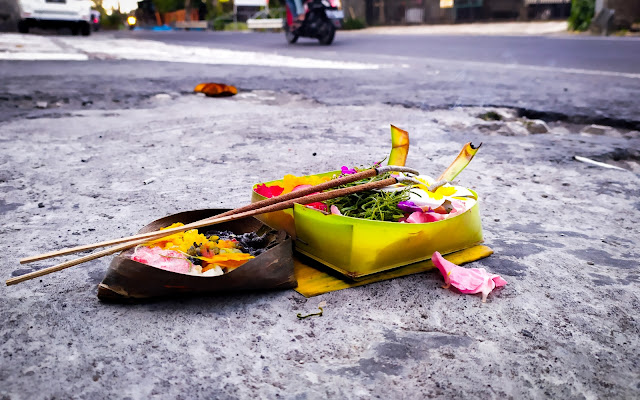Hindu Balinese send the Canang Sari to the gods every morning as a way to express gratitude for the harmony and tranquility that permeate our planet and are refreshed every day. The little offerings are the product of a protracted hand-made procedure in which women make the basket, arrange the gifts in a symbolic manner, and soak a jepun flower in holy water before scattering it on the canang to represent the union of the four elements. A brief prayer is said when incense smoke, the essence of the offering to the gods, leaves the rite.
A sacrifice for harmony and serenity
Canang Sari are performed as an expression of everlasting appreciation, unlike most religious rituals, which are performed in an effort to win God's favor. Their base, made from coconut leaf, betel nut, and lime, represents the three forces of creation, preservation, and union as they are represented by the three Hindu deities Brahma, Vishnu, and Shiva, respectively.
Each of the many petal hues has meaning as well, signifying a connection to a god and a direction. Iswara, the god of Nature, is represented by white petals in the east. Brahma receives red petals in the south, which stand for the power of creation. Yellow petals are a representation of Mahadeva and the west. Additionally, the color blue or green represents the north and the benevolent god Vishnu.
It's customary to see a small sum of money added to the gift as a sign of generosity. In order to serve as food for stray dogs, monkeys, and other animals, food items like sweets, crackers, and cookies are frequently placed next to flower petals in canang sari. As a result, throughout the day, ants, birds, dogs, and cats nibble on the adorable baskets as onlookers attempt to escape them with varying degrees of ability.
Unfortunately, if you hit one and try to make up for it by saying sorry to a Balinese, they will smile and tell you that it's not a big deal. What counts with Canang sari is giving someone else a truly selfless act. Giving as opposed to getting. Every morning, we should give thanks to God for giving us life, success, and happy moments, rather than wallowing in self-pity over what we missed.
However, as Bali's tourism economy has taken off, some of the ritualistic process of making sacrifices is occasionally fading into obscurity. Canang saris were traditionally made by women by hand every morning, which required daily time commitment as well as money commitment. The little offerings have gradually transformed into standardized items that can be obtained and bought from specialist vendors at the local markets as Bali has become more globalized and as more women work on the island. Because of this, the offerings continue to be a part of the Balineses' daily lives, but the significance of the tale behind their preparation is gradually changing.


 Posted by
Posted by 






comment 0 Comments
more_vert